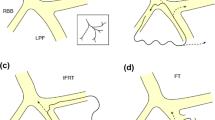Abstract
Sunao Tawara, who was born in 1873 and died in 1952, is considered the father of modern cardiac electrophysiology. He published his monumental monograph describing the atrioventricular conduction axis in 1906. He achieved this task in the face of multiple tribulations as a doctoral student working in a cultural environment that was not his own. Although his letters underscoring the publication of the monograph have been published, little emphasis has been placed on the potential problems he encountered in bringing his task to fruition. For example, it was not until the final 6 months of his studies that he resolved the issue of the connection between the atrioventricular bundle and the so called “Purkinje cardiomyocytes”. His exchanges with his mentor, Ludwig Aschoff, emphasized that the difficulties he encountered in making the connection caused him quite some turmoil. We believe that this issue, and others that he identified in his correspondence, are worthy of further attention.



Similar content being viewed by others
References
Akiyama T (2010) Sunao Tawara: discoverer of the atrioventricular conduction system of the heart. Cardiol J 17:428–434
Anderson RH, Mori S (2016) Wilhelm His Junior and his bundle. J Electrocardiol 49:637–643. https://doi.org/10.1016/j.jelectrocard.2016.06.003
Aschoff L (1904) Zur Myocarditisfrage. Verhandl d deutsch path Gesellsch 8:46–53
Aschoff L, Tawara S (1906) Die heutige Lehre von den pathologischanatomischen Grundlagen der Herzschwache. Gustav Fischer, Jena
Aschoff J (1993) Sunao Tawara, one of Ludwig Aschoff’s most prominent Japanese scholars. In: Suma K, Shimada M, Shimada T, et al. (eds) Selection from Tawara’s monograph: the conduction system of the mammalian heart. Organizing Committee of V Asia-Pacific Symposium on Cardiac Pacing and Electrophysiology and VIII Annual Meeting of the Japanese Society of Cardiac Pacing and Electrophysiology, Tokyo, pp 45–61
Heischkel-Artel E(1953) Aschoff, Ludwig. In: Neue Deutsche Biographie (NDB). Historischen Kommission bei der Bayerischen Akademie der Wissenschaften(Ed). Band 1, Duncker & Humblot, Berlin, p 413.
Keith A, Flack MW (1906) The auriculo-ventricular bundle of the human heart. Lancet 11:359–364
Kent AFS (1893) Researches on the structure and function of the mammalian heart. J Physiol 14:233–254
Loukas M, Linganna S, Chiba A, Tubbs RS (2008) Sunao Tawara, a cardiac pathophysiologist. Clin Anat 21:2–4. https://doi.org/10.1002/ca.20506
Silverman ME, Grove D, Upshaw CB (2006) Why does the heart beat? The discovery of the electrical system of the heart. Circulation 113:2775–2781. https://doi.org/10.1161/Circulationaha.106.616771
Suma K (2001) Sunao Tawara: a father of modern cardiology. Pacing Clin Electrophysiol 24:88–96
Suma K (2005) The father of pacemaker, Sunao Tawara. Azusa Shoin, Fukuoka 1st Japanese Edition
Suma K, Shimada M (1998) Translators’ Note. In: Tawara S (ed) The conduction system of the mammalian heart. Imperial College Press, London, pp 13–17
Suma K, Shimada M, Hori M, Mitsui T, Ueda K, Okawa S (eds) (1993a) Selection from Tawara’s monograph. 1st Edn. Organizing Committee of V Asia-Pacific Symposium on Cardiac Pacing and Electrophysiology and VIII Annual Meeting of the Japanese Society of Cardiac Pacing and Electrophysiology, Tokyo, 61pp
Suma K, Shimada M, Shimada T (1993b) Translators` Note. In: Suma K, Shimada M, Hori M, Mitsui T, Ueda K, Okawa S (eds) Selection from Tawra’s monograph, 1st edn. Organizing Committee of V Asia-Pacific Symposium on Cardiac Pacing and Electrophysiology and VIII Annual Meeting of the Japanese Society of Cardiac Pacing and Electrophysiology, Tokyo, pp 37–43
Suma K, Shimada M, Shimada T (eds) (2003) The life of Sunao Tawara: pioneering of the cardiology. Niigata: Microscopia Press, Niigata, p 257 1st Japanese Edition
Tawara S (1906) Das Reizleitungssystem des Säugetierherzens: EINE anatomisch-histologische Studie über das Atrioventrikularbündel und die Purkinjeschen Fäden. Gustav Fischer, Jena
Tawara S (1998) The conduction system of the mammalian heart : an anatomico-histological study of the atrioventricular bundle and the Purkinje fibers. 1st English Imperial College Press, London
Acknowledgements
We thank Dr Shumpei Mori, from University of California at Los Angeles, for providing us with a copy of the booklet edited by Shimada and his colleagues (1993) and entitled “Selections of Tawara’s monograph”.
Author information
Authors and Affiliations
Corresponding author
Ethics declarations
Conflict of interest
The authors declare that they have no conflict of interest.
Additional information
Publisher's Note
Springer Nature remains neutral with regard to jurisdictional claims in published maps and institutional affiliations.
Rights and permissions
About this article
Cite this article
De Almeida, M.C., Sanchez-Quintana, D. & Anderson, R.H. Sunao Tawara : further musings on his tribulations in providing the basis for the modern-day understanding of cardiac electrophysiology. Anat Sci Int 95, 381–386 (2020). https://doi.org/10.1007/s12565-020-00530-6
Received:
Accepted:
Published:
Issue Date:
DOI: https://doi.org/10.1007/s12565-020-00530-6




